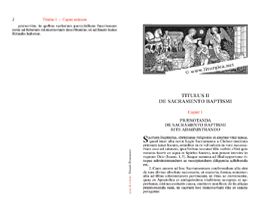PAULI V PONTIFICIS MAXIMI IUSSU EDITUM ALIORUMQUE PONTIFICUM CURA RECOGNITUM
In marked contrast to the Missale and the Breviarium Romanum there was no new Vatican edition of the Rituale Romanum in the early 1960s, just prior to the Second Vatican Council. Therefore the most recent version of the Rituale Romanum is the Editio typica of 1952 or the Vatican edition of 1957 respectively, which had been augmented by several rites of Benediction. These editions were published during the reign of Pope Pius XII. and consequently contained only the psalm translations approved by him. So until now there has been no edition of the Rituale Romanum representing the Editio typica of today, which makes use of the traditional translations of the psalms: the so-called Psalms of the Vulgate.
Yet the Rituale Romanum is the indispensable companion to a priest when he administers the sacraments, when he gives benedictions and when he fulfils his pastoral duties. So we take great pride in publishing this new edition and filling this gap. All the texts were newly prepared and set, and printing and book binding represent the very best craftsmen can offer.
When you click on a thumbnail picture you will be able to download a pdf-file with several specimen pages to illustrate the accompanying text.
Font and notes |
|
Contents, structure and changes in the Editio typica of 1952 |
|
Illustrations and Vignettes |
|
Content / Indices |



